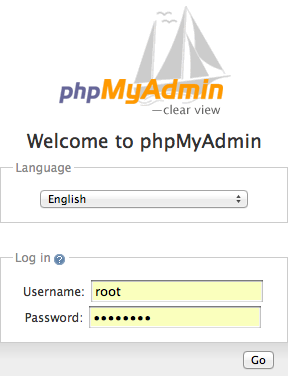
style.css - The stylesheet (CSS3) for our secure login system.index.html - The login form created with HTML5 and CSS3.Create the following directories and files:.Navigate to XAMPP's installation directory ( C:\xampp).We can now start our web server and create the files and directories we're going to use for our login system. Sessions are saved on the server and are associated with a unique ID that is saved in the browser. Session Management - Initialize sessions and store retrieved database results.Basic Validation - Validating form data that is sent to the server using GET and POST requests (username, password, email, etc.).
#Phpmyadmin login how to#
Prepared SQL Queries - How to properly prepare SQL queries to prevent SQL injection and therefore prevent your database from being exposed.Form Design - Design a login form with HTML5 and CSS3.
#Phpmyadmin login install#
It's not necessary to install all the software separately with XAMPP.ġ.2. It includes PHP, MySQL, Apache, phpMyAdmin, and more. XAMPP is a cross-platform web server package that includes the essentials for back-end developers.If you haven't got a local web server set-up, I recommend you download and install XAMPP.We need to set up our web server environment and ensure we have the required extensions enabled. There are a few steps we need to take before we create our secure login system. Creating the Database and setting-up Tables.

See all available options and their description on plugin’s settings page. Use it at your own responsibility (However, not more than 1% of users complained about having issues after using the plugin). However, we don’t control, check or revise the PhpMyAdmin package’s source code ot behavior itself, and thus, in overall, we take no responsibility about this plugin. This plugin uses official, unmodified (only whatever mentioned above) PhpMyAdmin package. We just made this plugin as a wrapper (container) of PhpMyAdmin, so, people could use it in WP. We are not developers of PhpMyAdmin itself, neither affiliated with them. Otherwise, for longer periods, you can deactivate plugin.
#Phpmyadmin login zip file#
zip file in the package (saying that SVN doesn’t like working with. zip directly upon plugin’s installation, but unfortunately WordPress Plugin Team didn’t allow to put. zip file untouched (to ensure the checksums are same) and unpack that. Also, initially we wanted to put PhpMyAdmin released. So, this current plugin is just a wrapper for official phpMyAdmin release and depends itself on the realiability & security of the phpMyAdmin itself. This plugin has been started from 2018 year, and we have no connections to the old age’s vulnerable wp-phpMyAdmin plugin (published elsewhere by 3rd party scammers).



 0 kommentar(er)
0 kommentar(er)
